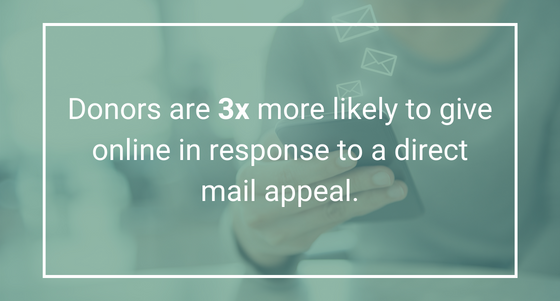The pandemic changed the way we do just about everything. From shopping to banking, the tasks that we used to venture out into the world to do are now all available to us without leaving our homes, including fundraising. While a strong digital fundraising component, such as donations pages, is critical to fundraising success, it’s important not to let your direct mail marketing strategy fall to the side.
When we think about direct mail, we tend to think it’s only popular with older generations, but that way of thinking could be leaving money on the table. Yes, direct mail does see the highest return coming from donors over the age of 60, but when combined with other elements such as email marketing or social media, direct mail can resonate strongly with donors of all ages.
So, now that you know it’s worth your time, how do you build your direct mail marketing strategy to raise as much as possible? This article is designed to help you do just that!
1. Nail Down Your Impact Messaging
Donors like to feel like they’re saving the day with their gift. Your job is to help them understand how they’re doing just that. Take a moment and put yourself in the mindset of your donor. Let’s say you received a piece of direct mail that told a brief story and then asked for a donation in the amount of your choosing, how much would you give?
Now, imagine that piece of direct mail asked you to give just $10 more than what you had originally planned, BUT you knew exactly what that extra $10 would do for the cause you’re supporting. Would you hesitate in giving that extra $10?Creating effective impact messaging is a team effort between your fundraising, marketing, and mission teams, but it starts with your fundraising metrics. Take a look at your last direct mail campaign and look for trends in giving amount. If the majority of your donors gave $100 through your last campaign, consider creating an impact statement tied to a value of $110 or $120 to increase your average gift size.
Download the 2023 Salaries Guide!
Use this FREE guide to ensure that your nonprofit remains competitive when attracting and retaining top talent in the industry! guide
2. Integrate Direct Mail with Other Channels
Remember when we mentioned that direct mail is most popular with older generations? The over 60 group may be most likely to respond directly to your appeal, but a multi-channel direct mail marketing strategy is the key to engaging donors of all ages.
Millennials and Gen Z are quickly becoming the monthly, major, and recurring donors of the future, so what if I told you that 84% of gen z’s that receive a piece of direct mail with a QR code will interact with it online? On top of that, 90% of millennials LOVE receiving mail and 57% of them act on direct mail offers from corporate brands.
The key to engaging younger donors is to make yourself known to them multiple times in several different ways. In fact, it can take 18-20 different touchpoints to reach a donor for the first time. Sending them a piece of direct mail is a great start, but it’s important to ensure that they are seeing your campaign in other places as well, such as through email and on social media.
3. Follow a digital-first approach
We’ve said it already, but we’ll say it again. Direct mail isn’t dead, but it is changing. With donors being 3x more likely to give online in response to a direct mail appeal over an email appeal, it’s clear that those little envelopes arriving in their mailboxes are making a difference.

By following a digital-first approach to your direct mail marketing strategy, not only are you offering donors multiple ways to give, but you could also be saving money.
Now hold on, it’s not time to give up on those business reply envelopes just yet, but by diving a little deeper into your donor information, you can be a bit more strategic.
Start by looking at your previous campaign and pulling out the people that mailed back the direct mail envelope, add in any other donors over the age of 60 and BOOM, there’s your shortlist for how many business reply envelopes you need! It’s still worth it to send mail to all donors, but adding in a QR code or link to donate online is likely a better fit for the majority of your prospects.
4. Segment, Segment, Segment
There isn’t a one-size fits all approach when it comes to asking for money. Donors want to feel like they are one of a kind, not one of many, and that all starts with segmentation.
Download the FREE Donor Segmentation Template
Use this FREE template to develop a personalized and targeted communications strategy! guide
By Past Donation Amount
Pull a list of all donors who have given to you through a campaign in the past and how much they gave. This is a great way to create your segments and increase your overall campaign revenue. Tying this back to impact statements, you can segment donors by previous giving amount and develop a custom ask that is slightly higher than what they have given in the past!
By Giving Capacity
Sometimes giving history doesn’t give the full story on how much a donor is able to give. By using wealth screening tools, you can segment your donors by their giving capacity. Bundle this with a custom ask for that amount and you’re sure to increase your average gift size!
Pro tip: There are TONS of tools out there that can do this work for you at a reasonable investment, so make sure you do a bit of research to determine what the best option is for your organization!
5. Think about Timing
Now, we don’t want to state the obvious, but with 30% of your donations arriving in December, year-end seems like a great choice to run your direct mail campaign.
Year-end is the perfect time to engage your donors and should definitely be part of your direct mail marketing strategy. Between bites of turkey and unwrapping gifts, the holiday spirit promotes generosity in your donors (plus the last chance to get a tax receipt isn’t a bad incentive either!)
Download The Ultimate Year-End Giving Checklist!
Use this FREE checklist to ensure that you have everything you need to run a successful year-end giving campaign!
Align the messaging and creative elements between your email marketing strategy, social media channels, direct mail efforts and telemarketing campaigns to ensure that your donors are seeing your campaign front and center on every platform they interact with!
Optimizing your direct mail marketing strategy can do more than just raise money for your cause. It can also help improve the quality of your relationships with your donors. Donors will always appreciate a personal, thoughtful approach to a solicitation. With direct mail, you can tick that box. There’s no better time than now to be thinking about your next direct mail campaign. Send out your campaign and watch the money start rolling in!

Meredith Gray
Senior Marketing Manager at Fundraising KIT
Meredith has always had a passion for work that makes an impact. Having spent over 7 years working in fundraising, she has gained extensive knowledge in marketing, peer-to-peer, events, and sponsorship and firmly believes that all successful fundraising strategies start with your data.
Having experienced it first-hand, she understands the challenges nonprofits face when building a fundraising strategy and loves connecting with other like-minded fundraisers to brainstorm new and creative ways to leverage data to increase revenue. When not working, Meredith can be found trying out one of Toronto’s diverse restaurants, breaking a sweat in a spin class, or researching her next travel destination.







